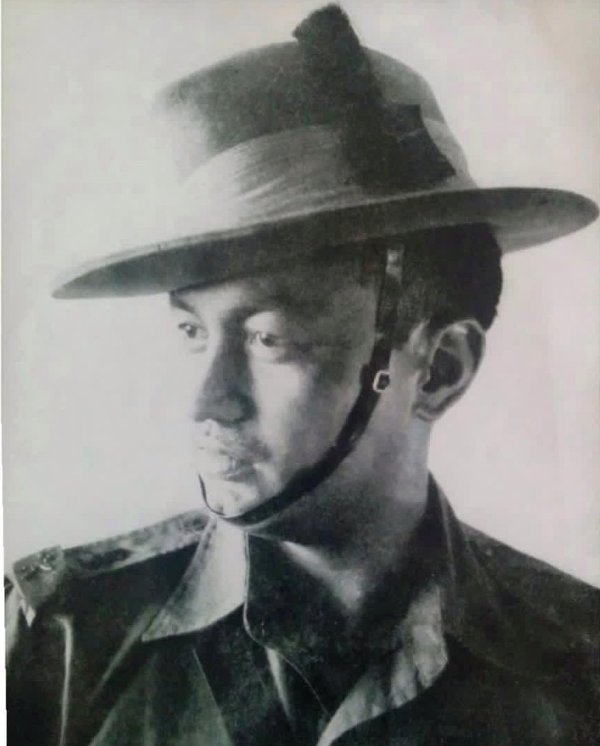PERSONAL INFORMATION
Profession: Army Personnel
Famous For: Being the recipient of the Param Vir Chakra (PVC) for his strategic action at the north of Pangong Lake during the 1962 Sino-Indian War
Date of Birth: 10 April 1928 (Tuesday)
Birthplace: Shimla, Himachal Pradesh
Age (at the time of death): 77 Years
Zodiac sign: Aries
Nationality: Indian
Hometown: Shimla, Himachal Pradesh
Age: 77 Years
Check Out Other Celebrities Biography
- aakash chopra biography
- paayel sarkar bengali actress biography
- fahmaan khan actor biography
- manasi naik aishwarya rais lookalike biography
- maitri bhanushali biography
PHYSICAL STATISTICS
Eye Colour: Black
Hair Colour: Black
FAMILY & RELATIONSHIPS
Marital Status: Married
Wife: Shukla Thapa
Children: Daughters – Madhulika Thapa, Poornima Thapa Son – Name Not Known Daughter-in-law – Anushree Thapa Note . He had two daughters and a son. [1] Zee News
Parents: Father – P.S.Thapa Mother – Name Not Known
CAREER HIGHLIGHTS
Awards, Honours, Achievements: Param Veer Chakra
OTHER INFORMATION
Service/Branch: Indian Army
Rank: • Lieutenant (29 September 1956) • Captain (21 February 1957)
Unit: 1/8 GR
Arm/Regt.: 8 Gorkha Rifles (1949)
Years of Service: 1949–1980
Operation: Operation Leghorn
Wars/Battles: Sino-Indian War (1962)
Date of Death: 5 September 2005
Place of Death: Lucknow, Uttar Pradesh
Hobbies: Playing Football, Playing Cards & Board Games, and Watching Movies
INTERESTING BACKGROUND INFORMATION
Lieutenant Colonel Dhan Singh Thapa, a distinguished Indian Army officer, was born into a Nepali family in Shimla, Himachal Pradesh. His remarkable bravery and unwavering dedication to his duties earned him India’s highest military honor, the Param Vir Chakra. Thapa’s legacy is particularly renowned for his gallant contributions during the 1962 Sino-Indian War. At that time, he was stationed at Sirijap, one of several outposts established along the contentious Himalayan border as part of then Prime Minister Jawaharlal Nehru’s “Forward Policy.” These strategic positions were meant to assert Indian presence in the region, but they also placed soldiers like Thapa in the eye of the storm when tensions escalated with China.
In October 1962, as hostilities intensified near the outposts surrounding Sirijap, the Chinese Army significantly ramped up its activities, ultimately signaling an imminent attack by deploying a large infantry force. Anticipating this assault, Thapa took proactive measures by instructing his troops to dig deep trenches for defense. On the morning of 20 October, the Chinese launched a fierce attack at 4:30 AM, employing heavy artillery and mortar fire that persisted for two and a half hours. Facing overwhelming odds and lacking artillery support, Thapa and his men found themselves in a precarious position as approximately 600 Chinese troops infiltrated the area. Despite being armed only with light machine guns and small arms, Thapa rallied his soldiers, inflicting significant casualties on the advancing enemy, even as the relentless bombardment claimed the lives of many Indian soldiers.
Throughout the brutal confrontation, Major Thapa, alongside his second-in-command, Subedar Min Bahadur Gurung, played a crucial role in maintaining the morale of their troops. As the Chinese forces escalated their assault using incendiary bombs, the Gorkhas—brave soldiers known for their tenacity—fought valiantly with grenades and small arms. Gurung displayed extraordinary courage, surviving a collapse in their bunker to continue the fight until he was ultimately killed. Meanwhile, Thapa remained at the forefront of the defense, directing his men even as the situation grew increasingly desperate. Attempts by battalion headquarters to assess the situation with storm boats proved disastrous, leading to substantial losses when one vessel sank, claiming the lives of its occupants.
Despite being captured by Chinese forces during a hand-to-hand skirmish, Thapa’s spirit remained unbroken. Initially, the Indian Army was informed of no survivors from the battalion, but later reports revealed that Thapa was alive and taken as a prisoner of war. His name was later broadcast on Chinese radio, bringing a wave of relief and joy to the people of India. Enduring his captivity with dignity, Thapa refused to denounce his country or its military, showing unwavering loyalty even in the face of adversity. After the war concluded in November 1962, he was released and returned to India, where he continued to embody the ideals of service and dedication throughout his life.
Retiring from the Indian Army on 30 April 1980, Thapa settled in Lucknow and briefly served as a director at Sahara Airlines. His commitment to the military remained strong, as he regularly attended army functions, including his final Republic Day parade despite suffering from kidney failure. Thapa’s cheerful demeanor and resilience left a lasting impression on those around him, earning him a beloved place in the hearts of many. His legacy endures through numerous landmarks named in his honor, including roads in Shillong, Assam, and Nepal, and a cargo vessel launched by the Shipping Corporation of India in 1984. Even after his passing on 5 September 2005, Major Dhan Singh Thapa’s contributions to Indian military history are commemorated with a statue at Param Yodha Sthal in Delhi, celebrating his valor and dedication as one of the few recipients of the Param Vir Chakra.
—
Note: All biographical information compiled from publicly available sources.
